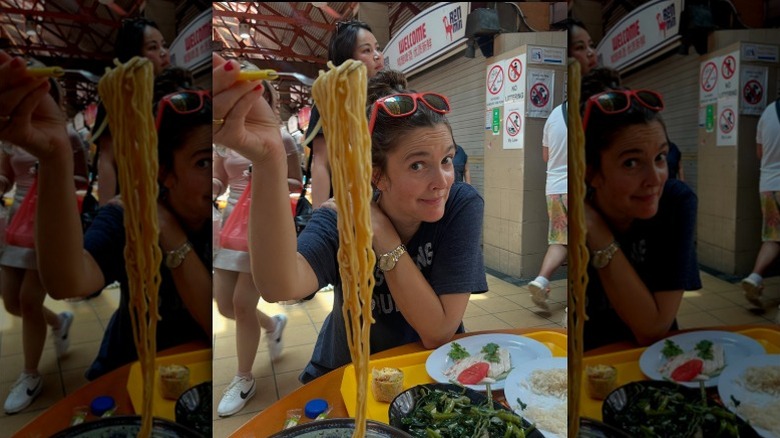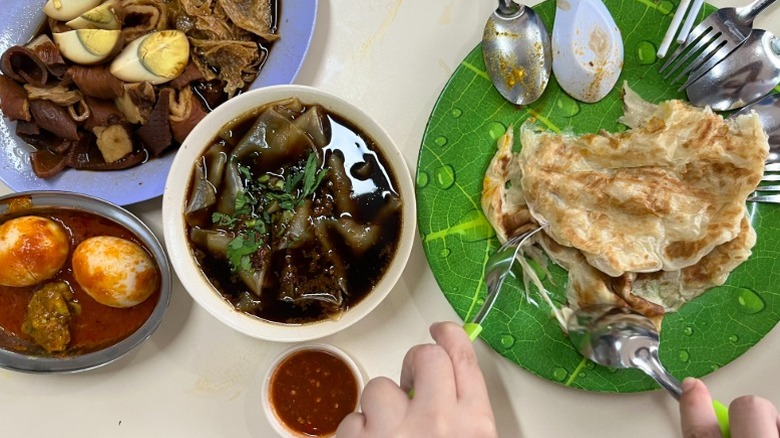This Country's Lively Street Food Culture Is A UNESCO-Approved Culinary Tradition Embraced By Celebrities
"Have you eaten?" is a common greeting in Singapore, where eating is a raison d'etre for socializing, or where socializing naturally gravitates towards eating. This usually unfolds at one of 122 hawker centers in this multiethnic city-state: Sprawling, open-air but roofed food courts with stalls slinging a seemingly infinite scroll of local heritage dishes where a full meal with drink and dessert rarely costs more than $10. Think Anthony Bourdain favorites like the Chinese chicken rice, Malay nasi lemak coconut rice, Indian crispy roti prata flatbread, and intrinsically Singaporean chili crab — dishes that inspired him to declare the country as one of his favorite food destinations across the globe.
He is not the only celebrity hooked. Drew Barrymore raved about "incredible hawker centers with the most delicious street food you've ever tasted," Dua Lipa hyped that her Singapore stop was "powered by sour plum juice, chili crab, and laksa," while Ed Sheeran gushed over coconut jam kaya toast and rojak tropical fruit salad.
This hawker culture took root soon after the British founded the port of Singapura in 1819, drawing swells of emigrants from mostly China, Indonesia, and India. To satiate appetites of these laborers who arrived alone and needed quick sustenance for manual work, street peddlers sprang up across waterfront docks, the town center, and housing areas, dishing noodles, curries, and meats reminiscent of home. Naturally, vibrant regional ingredients and vivid provincial flavors came together in a harmonious melting wok, creating a new culinary tradition of fusion cuisine eaten at makeshift roadside tables and stools. These itinerant vendors were resettled into hawker centers in the early 1970s, evolving into "communal dining rooms" inscribed on UNESCO's Intangible Cultural Heritage of Humanity list in 2020. This is the real Singapore, where people from all walks of life, races, and identities mingle over meals, not "Crazy Rich Asians."
Singapore's lively street food culture is UNESCO-approved
At the heart of every Singaporean neighborhood is a hawker center, with stalls coming to life at 7 a.m. and cooking as late as midnight. The hypnotic aroma of local Nanyang coffee roasted with butter and sugar sets the tone in the mornings and during lunch rush, downtown centers bustle with business-dressed professionals and tourists tucking into midday meals. Singaporeans love snacking throughout the day, so hawker centers are never completely quiet, but they're at their most diverse in the evenings, from families clustered around tables to folks grabbing takeout. Whenever frying is in action, watch how flames soar and envelop industrial-size woks, the emblem of an exceptionally skilled chef. The animated chorus of ladles clanging around pots, convivial chatter, and cheerful buskers complement the colorful splay of melamine platters and bowls on your table brimming with Singapore's culinary heritage.
The country's most iconic hawker centers are national treasures home to a high concentration of acclaimed stalls serving famous renditions of street food. Lau Pa Sat in the heart of the Central Business District is the only national monument, a former Victorian-style fish market completed in 1894 with trademark clock tower from London. Find an outdoor perch on its Satay Street at sunset for a taste of al fresco sidewalk eating dedicated to these zesty charcoal-grilled meat skewers. Chinatown Complex is a vast labyrinth where you can find more nostalgic dishes. East Coast Lagoon Food Village is a beachside paradise for the palate. Tekka Centre is a beguiling cornucopia of South Asian specialties, while Geylang Serai Market offers a dazzling diaspora of dishes birthed from Malay and Indonesian archipelagos. Tiong Bahru Market and Old Airport Road are neighborhood classics beloved for their generations-old mom-and-pop stalls.
Savoring Singapore's culinary tradition like a local
Singapore's sumptuous hawker legacy comes with sides of delightful quirks for whole-heartedly embracing the most authentic eating experience. Locals traipse all over the 31-by-17-mile island seeking perfect versions of hawker dishes, and you'll always find exquisite eats wherever you explore. For example, fried Hokkien mee and char kway teow are two quintessential noodle dishes to dig into at Lau Pa Sat, just a 20-minute walk from the fantastical "Supertrees" at futuristic Gardens by the Bay. Don't be shy about sharing a table with friendly locals if you're solo, or simply plop down a pocket-size pack of tissues to chope (slang for "reserve") your spot while you wander off to gather nosh. Beat the heat by sipping refreshing coolers like barley water, sugarcane and lime juices, and the hometown Tiger Beer poured over a mug of ice.
When in doubt, join the longest line in any hawker center, the sign of a stall's culinary prowess, and revel in the signature Singaporean FOMO sentiment that every meal has to be the best. This was also Bourdain's trick for finding the best local eateries when traveling, telling Bon Appetit that he checks where "locals are willing to inconvenience themselves and wait in line for a long time to get something that only costs a dollar fifty." These days, hawker centers are also abuzz with a new wave of cooks infusing heritage recipes with modern and international flourishes, an intriguing blend of Singapore's past and present. They're using ramen in noodle dishes, upgrading humble min jiang kueh pancakes with fillings like Nutella, black sesame, and Biscoff, and barista-ing up local kopi as cappuccino, cold brews, and with Western-style flavors like hazelnut and caramel, keeping Singapore's culinary traditions fun and relevant for modern palates.


